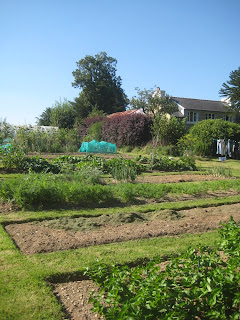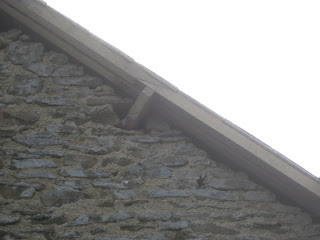I've been reading some interesting (for me) books and
on-line articles about proper building. Basically, everything you need for a beautiful, healthy, long-lasting building has been thought out and developed hundreds and sometimes thousands of years previously. Every place on earth has the prefect materials for a decent home. Here we have oak, slate, stone and earth. In other places you have bamboo, teak, clay, lime. It is all just there, out of the window (ok, no windows out there, but you get the idea). Anything else is generally ugly, polluting and temporary. I might expand on this later, when I've taken some photos of buildings around here to illustrate my point.
So, I am renovating our house and am trying to use as much locally sourced material as possible, and am recycling as much as I can in a wee journey of discovery of old methods and materials.
So far I've stripped the cement render off. I needed an SDS drill for this as the render was almost pure cement and very, very hard. Renders are there to protect the wall, and act as a sacrificial coating - it wears away so the structure doesn't. On a rubble stone house with earth mortar with no foundations, movement is inevitable as the soil expands and shrinks during the year. It's fine. Cement doesn't move though - it is very strong, impervious and resists movement up to it's breaking point, when it just cracks. Cracks let in water which then can't get out again. This equals a cold, damp house. Cement is great for railway bridge footings, anti-tank emplacements and other grim uses. This is what it was developed for. Not for use on houses.

The original stonework is very well put together. It is basically rubble from the fields bedded with clay sub-soil (mortar is there to spread the load of the stone on top so it doesn't crack - soil is good for this as long as it doesn't wash away), joined very closely like a jigsaw where non of the pieces fit properly and you still have to make a picture. As you can see, there was a window put in later in the house's history (you can see a rectangular hole to the right of the window which is where the original fireplace wooden beam was - the other was removed for the window to go in) - compare the stonework above it with the original. De-skilling of society is another rant!
On the other side of the house, we've got the electric coming in and access above the boiler room was difficult so instead of being electrocuted I removed the render in line with the drainpipe to hide the join when the house is re-rendered in haired lime.
Bread oven also gone! This was going to make way for a new window as we were going to move the bathroom to the lighter, warmer side of the house but the drainage won't work. Again, look at the white rectangle and the stonework there. This was a door into the larder, and will be again. It was just bricked up with concrete blocks and the other side is black with mould. Not for long though.
Where did the oven go?
Into the hangar! Two 1m cubed bags of earth mortar and about 4m cubed of very heavy stone, plus a ton of fire-bricks, slate and oak will be made into a workshop floor and a pizza oven in the garden at some point.
Next is repairing and plugging holes, making doorways, vents for larder, re-pointing the front. Then we're replacing the gable end roof wood (rotten because painted over badly), re-flashing the chimney, re-slating a bit, demolishing the bread oven chimney, then rendering the walls (3 coats plus lime-wash)!
Makes me tired just thinking about it! Good fun though!



















































